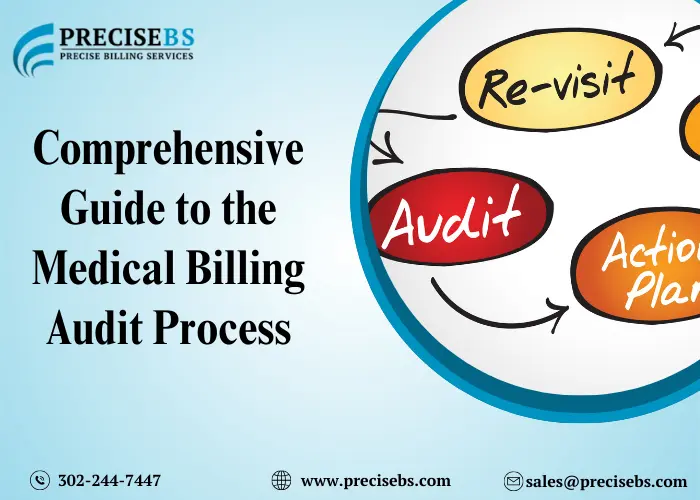Medical billing audits are essential for ensuring accuracy, compliance, and financial integrity in healthcare organizations. This detailed examination of billing records and processes helps identify discrepancies, prevent fraud, and optimize revenue cycles. In this comprehensive guide, we will explore the medical billing audit process, its significance, steps involved, and best practices for achieving effective outcomes.
Have you ever felt a chill run down your spine when you hear the term “medical billing audit”? You’re not alone. For healthcare providers in the US, the prospect of an audit can be daunting. But fear not! This guide will equip you with the knowledge to navigate the medical billing audit process with confidence.
What is the Medical Billing Auditing Process?
Medical billing is a crucial aspect of healthcare administration, ensuring that healthcare providers are reimbursed for their services. However, the complexity of billing processes often leads to errors, which can result in significant financial losses and compliance issues. This is where medical billing auditing comes into play. In this comprehensive guide, we will explore what the medical billing auditing process entails, its importance, and how it can benefit healthcare providers in the USA.
Table of Contents
Understanding Medical Billing Audits
Medical billing audits involve a systematic review of healthcare provider’s billing records to ensure that all claims submitted to insurance companies are accurate, complete, and compliant with applicable regulations and guidelines. These audits are crucial in maintaining the financial health of healthcare practices and preventing issues related to overbilling or underbilling.
Importance of Medical Billing Audits
- Accuracy and Compliance: Ensures billing accuracy and compliance with federal, state, and payer-specific guidelines.
- Fraud Prevention: Helps in detecting and preventing fraudulent activities, reducing the risk of financial penalties.
- Revenue Optimization: Identifies areas of revenue leakage and helps in optimizing the revenue cycle management.
- Quality Improvement: Provides insights into operational inefficiencies, leading to overall improvement in healthcare quality and service delivery.
Importance of Medical Billing Audits
Unveiling the Medical Billing Audit Process: A Step-by-Step Guide
The medical billing audit process can be internal (conducted by the provider) or external (initiated by a payer or government agency). Here’s a simplified breakdown:
- Planning, Preparation and Defining the Scope:
- What’s getting audited? This could be a random sample of claims, specific services, or a provider’s entire billing practices.
- Define Objectives: Establish clear goals and objectives for the audit.
- Select Audit Team: Choose a team with appropriate expertise in medical billing and coding.
- Determine Scope: Define the scope of the audit, including the time period and types of services to be reviewed.
- Data Collection: Medical records, coding notes, and claim submissions are assembled for the audit period.
- Gather Documentation: Collect all relevant documents, including patient records, billing statements, and insurance claims.
- Electronic Health Records (EHR): Ensure access to EHR systems for comprehensive data collection.
- Compliance Policies: Review compliance policies and guidelines applicable to the audit.
- Review and Data Analysis: The audit team, often comprising medical coding and billing specialists, meticulously examines the documentation.
- Coding Accuracy: Check for accuracy in medical coding and ensure that the codes match the services provided. The assigned codes correctly reflect the services rendered.
- Billing Accuracy: Verify that billing statements are accurate and reflect the services rendered.
- Complete documentation: Medical records support the billed services and diagnoses.
- Regulatory Compliance: Ensure that all claims comply with federal, state, and payer-specific regulations. Billing practices adhere to government and payer guidelines.
- Findings and Corrective Actions: The audit report summarizes identified errors and potential overpayments/underpayments. A plan for correcting mistakes and preventing future occurrences is developed.
- Error Correction: Implement corrective actions to address identified errors.
- Training and Education: Provide training to staff on proper billing and coding practices.
- Policy Updates: Update policies and procedures to prevent future errors.
- Reporting and Follow-up: The provider addresses identified issues, communicates with payers if necessary, and implements corrective actions to ensure ongoing compliance.
- Audit Report: Prepare a detailed audit report summarizing findings, discrepancies, and corrective actions taken.
- Management Review: Present the report to management for review and approval.
- Follow-up Audits: Conduct follow-up audits to ensure that corrective actions have been implemented and are effective.
Types of Medical Billing Audits
There are two main types of medical billing audits in the US:
- Prepayment Audits: These audits occur before a claim is paid by the insurer. They focus on verifying patient eligibility, service necessity, and coding accuracy.
- Internal Audits: These audits are conducted by the healthcare organization’s own staff or a third-party auditor hired by the organization. These audits are proactive measures to identify and rectify issues before external audits.
- External Audits: These audits are conducted by external entities such as insurance companies, Medicare, or Medicaid. These audits are typically more rigorous and can result in significant penalties if discrepancies are found.
- Post Payment Audits: These audits happen after a claim has been paid. They delve deeper into a sample of claims to identify any billing errors or discrepancies.
- Prospective Audits These audits are conducted before claims are submitted to payers. The focus is on preventing errors and ensuring that all claims are accurate and compliant from the outset.
- Retrospective AuditsThese audits are conducted after claims have been submitted and processed. The primary goal is to identify and correct any errors or discrepancies in the billing records.
Click here for More Information: Types of Medical Billing Audits

